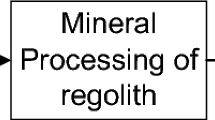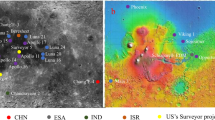Abstract
Regolith, the surface material from terrestrial planetary bodies such as the Moon, Mars, and asteroids, is extremely expensive and rarely available for scientists and engineers to use when developing new technology. Different technologies work better in different materials, so since failure is not an option in space missions it is necessary to understand how a technology will behave in the materials it may encounter in space. To address this, planetary surface simulants have been developed to offer a low-cost alternative to planetary materials. They are made to reflect either physical, mineralogical, or chemical properties of lunar, Martian, and asteroidal rocks and regolith. A wide variety of regolith and volatile simulants have been used since the Apollo program that have differed based on the planetary body of interest, available material, and physical attribute tested. In-situ resource utilization (ISRU) technology development requires simulant with geotechnical attributes unlike those required before. Interaction between regolith simulant and the test environment has also proven more important for ISRU technology development than for purely mechanical technology for exploration. This chapter examines the background of regolith simulant development for a variety of planetary bodies and the efficacy of the ways they have been used.
Access this chapter
Tax calculation will be finalised at checkout
Purchases are for personal use only
Similar content being viewed by others
References
Allen, Carlton C., et al. 1997. JSC Mars-1-Martian regolith simulant. Lunar and Planetary Science Conference, vol 28.
Allen, Carlton C., et al. 1998. Martian soil simulant available for scientific, educational study. Eos, Transactions American Geophysical Union 79(34):405‒409.
Atkinson, J., and K. Zacny. 2018. Mechanical properties of icy lunar regolith: application to ISRU on the Moon and Mars. In Earth and Space 2018: Engineering for Extreme Environments. Reston, VA.
Atkinson, Jared, et al. 2019. Penetration and relaxation behavior of dry lunar regolith simulants. Icarus 328:82‒92.
Battler, M.M., et al. 2006. Developing an anorthositic lunar regolith simulant. In 57th International Astronautical Congress.
Blewett, David T., et al. Lunar simulant assessment. Johns Hopkins University Applied Physics Laboratory.
Bonitz, Robert G., et al. NASA Mars 2007 Phoenix lander robotic arm and icy soil acquisition device. Journal of Geophysical Research: Planets 113(E3).
Britt, Daniel, Steven D. Covey, and Cody Schultz. 2017. University of central Florida/deep space industries asteroid regolith simulants. DPS.
Britt, Daniel T., et al. 2019. Simulated asteroid materials based on carbonaceous chondrite mineralogies. Meteoritics & Planetary Science 54(9):2067‒2082.
Cannon, Kevin M., et al. 2019. Mars global simulant MGS-1: A Rocknest-based open standard for basaltic Martian regolith simulants. Icarus 317:470‒478.
Debenedetti, Pablo G. 2003. Supercooled and glassy water. Journal of Physics: Condensed Matter 15(45):R1669.
Fries, Marc, et al. 2010. Extralunar materials in lunar regolith. A White Paper Submitted for the NRC Decadal Survey.
Fukazawa, Hiroshi, et al. 2006. Existence of ferroelectric ice in the universe. The Astrophysical Journal Letters 652(1):L57.
Gaier, James R., and Ronald A. Creel. 2005. The effects of lunar dust on advanced EVA systems: Lessons from apollo. Presentation Jan.
Gault, Donald E., Eugene M. Shoemaker, and Henry J. Moore. 1963. Spray ejected from the lunar surface by meteoroid impact. National Aeronautics and Space Administration.
Gertsch, Leslie, Robert Gustafson, and Richard Gertsch. 2006. Effect of water ice content on excavatability of lunar regolith. In AIP conference proceedings, vol. 813(1), American Institute of Physics.
Gustafson, G. 2009. JSC-1A lunar regolith simulant: availability and characterization. In 2009 Lunar Regolith Simulant Workshop.
He, Chunmei. 2010. Geotechnical characterization of lunar regolith simulants. Diss: Case Western Reserve University.
Housen, Kevin R., and Keith A. Holsapple. 2003. Impact cratering on porous asteroids. Icarus 163 (1): 102–119.
Housen, Kevin R. 1992. Crater ejecta velocities for impacts on rocky bodies. In Lunar and Planetary Science Conference, vol 23.
Kleinhenz, Julie E., and R. Allen Wilkinson. 2014. Development and testing of an ISRU soil mechanics vacuum test facility.
McKay, David S., et al. 1991. The lunar regolith. In Lunar sourcebook, vol 7. New York: Cambridge Univ. Press, 285‒356.
McKay, David S., et al. 1994. JSC-1: A new lunar soil simulant. In Engineering, construction, and operations in space IV 2, 857‒866.
Metzger, Philip T., et al. 2019. Measuring the fidelity of asteroid regolith and cobble simulants. Icarus 321:632‒646.
Muscatello, Anthony, and Robert Bob Gustafson. 2010. The 2010 field demonstration of the solar carbothermal reduction of Regolith to produce oxygen. In 11th Space Resources Roundtable: Planetary and Terrestrial Mining Sciences Symposium; 6‒8 June 2010, Golden, CO.
Perminov, V. G. 1999. The difficult road to Mars: a brief history of Mars exploration in the Soviet Union. National Aeronautics and Space Administration Headquarters.
Peters, Gregory H., et al. 2008. Mojave Mars simulant—Characterization of a new geologic Mars analog. Icarus 197(2):470‒479.
Rickman, D.L., C.M. Schrader, and J.E. Edmunson. 2010. Generation of requirements for simulant measurements. In NASA Technical Memorandum 2010–216445, NASA Marshall Space Flight Center, Ala.
Salisbury, John W., and Peter E. Glaser. 1964. Studies of the characteristics of probable lunar surface materials. Little (Arthur D) Inc., Cambridge, MA.
Sanders, Gerald B., and William E. Larson. 2012. Progress made in lunar in situ resource utilization under NASA's exploration technology and development program. In Earth and space 2012: Engineering, science, construction, and operations in challenging environments.
Sanders, Gerald B. Overview of past lunar in situ resource utilization (ISRU) Development by NASA.
Schultz, Peter H., and Donald E. Gault. 1986. Momentum transfer from oblique impacts. In Lunar and planetary science conference, vol 17.
Sercel, J., et al. Microgravity granular material research facility for ISS. In Earth and Space 2018: Engineering for Extreme Environments, Reston, VA.
Sibille, Laurent, et al. 2006. Lunar regolith simulant materials: recommendations for standardization, production, and usage.
Stoeser, D., D. Rickman, and S. Wilson. 2011. Design and specifications for the highland regolith prototype simulants NU-LHT-1M and-2M.
Suescun-Florez, Eduardo, et al. 2015. Geotechnical properties of BP-1 lunar regolith simulant. Journal of Aerospace Engineering 28(5):04014124
Tanaka, Kenneth L., et al. 2014. Geologic map of Mars.
Taylor, Lawrence A., Carle M. Pieters, and Daniel Britt. 2016. Evaluations of lunar regolith simulants. Planetary and Space Science 126: 1–7.
Taylor, G.Jeffrey, P.G. Lucey, and N. Schörghofer. 2007. The Science of the Lunar Polar Volatile Deposits. AAS 210:71‒103.
Taylor, Lawrence A., and Yang Liu. 2010. Important considerations for lunar soil simulants. In Earth and space 2010: Engineering, science, construction, and operations in challenging environments, 106‒118.
Thermal-Vacuum Testing. 2011. Facility Testing Information. Johnson Space Center, National Aeronautics and Space Administration. https://www.nasa.gov/centers/johnson/pdf/639724main_Thermal_Vacuum_Testing_FTI.pdf. Accessed 12 Oct 2020.
Williams, Hunter, and Evan Butler-Jones. 2019. Additive manufacturing standards for space resource utilization. Additive Manufacturing 28: 676–681.
Williams, Hunter. 2021. Simulant and environment requirements for space resources technology development. In Earth and Space 2021: Engineering for Extreme Environments.
Yano, H., et al. 2000. Trajectory planning and sampling technology of asteroid family multiple fly-bys and sample return mission.
Zacny, Kris, et al. 2013. Asteroid mining. In AIAA Space 2013 Conference and Exposition.
Zacny, Kris, et al. 2020. Pneumatic Sampler (P-Sampler) for the Martian Moons eXploration (MMX) Mission. In 2020 IEEE Aerospace Conference. IEEE.
Author information
Authors and Affiliations
Corresponding author
Editor information
Editors and Affiliations
Rights and permissions
Copyright information
© 2023 Springer Nature Switzerland AG
About this chapter
Cite this chapter
Williams, H. (2023). Simulants in In-Situ Resource Utilization Technology Development. In: Badescu, V., Zacny, K., Bar-Cohen, Y. (eds) Handbook of Space Resources. Springer, Cham. https://doi.org/10.1007/978-3-030-97913-3_10
Download citation
DOI: https://doi.org/10.1007/978-3-030-97913-3_10
Published:
Publisher Name: Springer, Cham
Print ISBN: 978-3-030-97912-6
Online ISBN: 978-3-030-97913-3
eBook Packages: Physics and AstronomyPhysics and Astronomy (R0)




